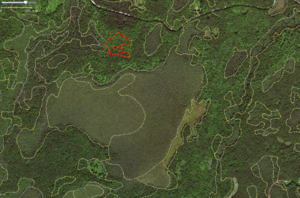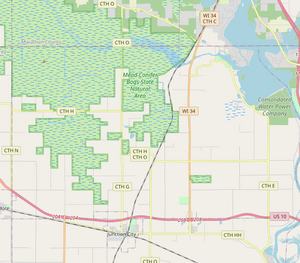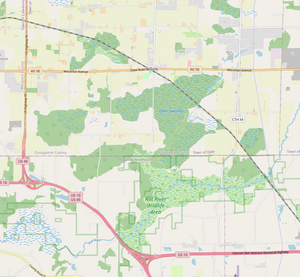Import/Wisconsin Wetlands
Goals
To add the the wetlands (swamps, marshes, bogs, etc.) in the state of Wisconsin while avoiding duplicating existing tagged wetlands This import is currently being drafted.
It is hoped that the success of this import can be a guide to importing the data in other state as well.
Progress/Schedule
This import is currently being drafted.
Import Data
Background
Data source site: https://www.fws.gov/program/national-wetlands-inventory/wetlands-mapper
Data license:: Public Domain
Type of license: Public Domain
Link to permission: n/a
ODbL Compliance verified: Yes
The datasource contains the following notice of the limitations of the data:
The U.S. Fish and Wildlife Service's (Service) objective of mapping wetlands and deepwater habitats is to produce reconnaissance level information on the location, type and size of these resources. The maps are prepared from the analysis of high altitude imagery. Wetlands are identified based on vegetation, visible hydrology and geography. A margin of error is inherent in the use of imagery; thus, detailed on-the-ground inspection of any particular site may result in revision of the wetland boundaries or classification established through image analysis. The accuracy of image interpretation depends on the quality of the imagery, the experience of the image analysts, the amount and quality of the collateral data and the amount of ground truth verification work conducted. Metadata should be consulted to determine the date of the source imagery used and any mapping problems. Wetlands or other mapped features may have changed since the date of the imagery and/or field work. There may be occasional differences in polygon boundaries or classifications between the information depicted on the map and the actual conditions on site.
Nonetheless, after inspection of the the dataset, it is clear that the the data is very precise and accurate. The results are likeley better than what mappers would be able to produce themselves due to the inherient difficulties in mapping wetlands (especially forested wetlands), including the need for knowledge of hydrology.
The classification system used in the dataset uses the Classification of Wetlands and Deepwater Habitats of the United States initially developed by Lewis M. Cowardin et al for the Fish and Wildlife Service which differs significantly from the system in use in OSM. The authors provide the following explaination for forgoing the traditional terms (swamp, marsh, etc):
Our initial attempts to use familiar terms such as marsh, swamp, bog, and meadow at the Class level were unsuccessful primarily because of wide discrepancies in the use of these terms in various regions of the United States. In an effort to resolve that difficulty, we based the Classes on the fundamental components (life form, water regime, substrate type, water chemistry) that give rise to such terms. We believe that this approach will greatly reduce the misunderstandings and confusion that result from the use of the familiar terms.
The classification code (wherefrom all metadata of a given wetland can be derived) will therefore be maintained in order to allow OSM tags to be upgraded in case more specific tags are ever introduced to OSM (e.g. soil type, water regimes, water acidity)
Import Type
A one time import that will be completed in many small uploads.
Data Preparation
Data Reduction & Simplification
Given the high number of nodes in the ways in the data, the ways were simplified in JOSM using a maximum variance of 5 metres. The data will be split into tracts with at most 1000 ways for easier management.
Tagging Plans
Water features will not be imported. All ways will be tagged with natual=wetland. In addition, the type of wetland (wetland=*) will be tagged according to the following table:
| Wetland type | Map- Wetland class |
Name | Description | OSM tags |
|---|---|---|---|---|
| Freshwater Emergent Wetland | PEM | Palustrine emergent | Characterized by erect, rooted, herbaceous hydrophytes, excluding mosses and lichens. This vegetation is present for most of the growing season in most years. These wetlands are usually dominated by perennial plants. | natural=wetland + wetland=marsh |
| Freshwater Emergent Reedbed Wetland | PEM5 | Palustrine emergent (Phragmites australis) | These wetlands are usually dominated by Phragmites australis. | natural=wetland + wetland=reedbed |
| Freshwater Shrub Wetland | PSS | Palustrine Scrub-Shrub | Includes areas dominated by woody vegetation less than 6 m (20 feet) tall. The species include true shrubs, young trees (saplings), and trees or shrubs that are small or stunted because of environmental conditions. | natural=wetland + wetland=swamp |
| Freshwater Forested Wetland | PFO | Palustrine forested | Characterized by woody vegetation that is 6 m tall or taller. | natural=wetland + wetland=swamp |
- Wetlands with the water regimes of "Intermittently Flooded" and "Temporarily Flooded" will be tagged with intermittent=yes.
- When a leaf type or cycle is specified in the dataset, it will be tagged with leaf_cycle=* or leaf_type=*.
- The wetland classification according to the Fish and Wildlife service will be tagged with wetland:classification:cowardin=*.
It was considered to tag seasonally wet wetlands with seasonal=*. Unfortunately, the OSM definition of seasonal=* is too vaguely defined to make this useful. (e.g. is a seasonally flooded wetland with constant soil saturation seasonal=yes?)
Changeset Tags
The changeset should have source=National Wetlands Inventory
Data Transformation Results
Data Merge Workflow
Team Approach
While getting local consensus, active local mappers will be asked if they want to participate in merging the data. This OSM wiki page will host a table to track the progress of each tract.
Feel free to leave your name here if you are interested in merging the data:
Workflow
Preparation
- Find any wetlands already mapped in the import area. This can be done easily with an overpass query into JOSM.
- Exclude any wetlands from the dataset which have already been mapped. The exception is when natural=wetland has been applied to a whole natural area without disgretion of the actual wetland on the ground. (see the included images)
- Look for any swamps which have been mistagged as natural=wood. These can simply be retagged as a swamp.
Import
Note: Do all import via a dedicated import account
- Load one section of the wetlands files into JOSM
- Where the wetlands are directly adjacent to another landuse, we want to merge to edges. This can be done easily with the JOSM Plugin ContourMerge
- If a wetland is within another feature (a bog surrounded by a forest already mapped), the surrounding feature should be made a multipolygon.
- Upload the section in JOSM (this will most likely require uploading in chunks, which JOSM handles manually


